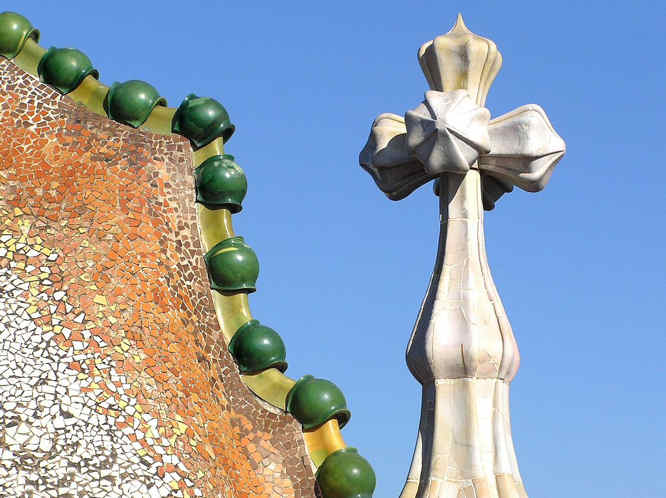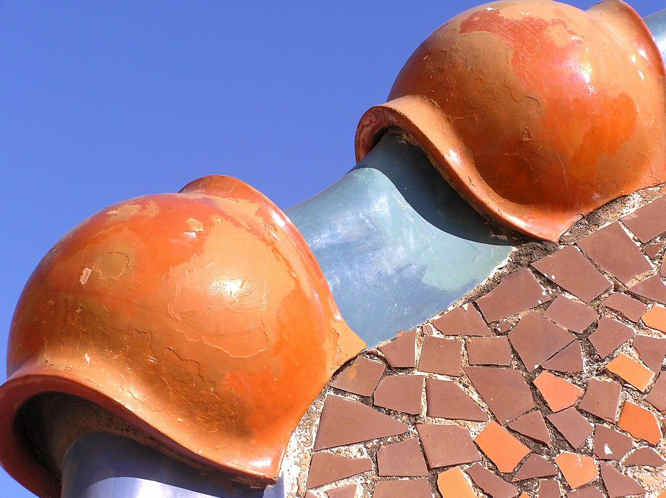Barri Gotico - Barcelona's Gothic Quarter
This is the Area of Barcelona where you get transported back in time to medieval Europe. It is a maze of twisting, dark cool and atmospheric narrow streets that open out on to cobbled squares of different sizes. Your will find Barcelona's great cathedral that dates back to the 14th century, churches, small shops and cafes

It is a nice place to explore in the heat of the day. As you walk around the cobbled streets look up as many of the houses have ornate balconies. You will find a mixture of building styles, from roman, medieval Romanesque, Gothic and late Renaissance. It is nice to get away from all the noise, bustle and heat of the modern part of the city and wander around in this quiet medieval gothic quarter.
The Cathedral has been constantly updated over the centuries with impressive additions such as the late 19th century facade. The square in front of the cathedral called the placa de la seu is worth a stop for a coffee or tapas. The entrance to the Cathedral can be found along the beautiful C. del Bisbe Irurita. If you carry on walking down that road you end up in the magnificent square, Placa Sant Jaume. It was the historical and political heart of the city. It contains to elegant buildings that face each other, the Ajuntament and the Palau de la Generalitat.
The impressive Palau de la Generalitat in Placa Sant Jaume was the home of Catalonia's parliament in the 15th century. The facade stands out from the rest of the buildings as it is more late Renaissance than the earlier Gothic exterior style of the other buildings. It has undergone many structural changes over the years. It is open to the public on April 23rd and September 24th.

The Ajuntament in the Placa Sant Jaume is Barcelona's Casa de la Ciutat or town hall. It was first used as a seat of power for the counsel of 100 Consell de Cent in the 14th century. Except for the front entrance the exterior has lost much of its Gothic features.
It is open to the public on Saturday or Sunday between 10am-2pm. Most of the interior was badly damaged during a bombardment during the Spanish Civil War. It has been restores and the grand staircase is worth a visit. If you are lucky there may be some special exhibition being held.
In the 1920's an ariel walkway or bridge was built between two of the old buildings. They modelled this medieval gothic reconstruction on the Bridge of Sighs in Venice. It has become one of the most photographed bridge in Barcelona. Most tourists go away believing that it is very old.
You will find it above the road called Carrer de Bisbe on Calle Bisb. There are always proficient street musicians in the area playing expensive musical instruments. They add a mysterious and enchanting feel to the area. When I was there a flea market was in the Placa Reial on Sunday, the Placa del Pi on Monday and in front of the cathedral on Thursday.
Look on your map for the town square called Placa de Sant Josep Oriol. It is one of the prettiest in the Gothic quarter surrounded by some of the quaintest little streets, lined with cafes and restaurants
Roman ruins
There are even some Roman ruins not far from the Cathedral. The Roman towered entrance to Barcino is still visible. Though they have now been incorporated into more modern buildings, much of the old Roman walls and towers still exist.
If you like roman history and architecture below the Plaza de la Seu and as a part of the Palau Episcopal and Casa de l'Ardiaca, you can still see remnants of the old Roman aqueduct that was used to bring fresh water into the city from the surrounding hills. Behind the cathedral and near the Carrer del Bisbe more of the Roman walled city is visible in other areas of the Barri Gotic.
There are some signposts which display a map and a description of what it is that you are looking at. They also detail a "Roman Walk" that you can take to see all of these old parts of Barcelona.
There are remnants of an old Roman Temple near the central part of an old Roman settlement which stood near Plaza Jaume. This is a hard to locate. From Plaza St. Jaume go down the street towards the metro station. Take the 2nd left, the alley curves off to the right. The Centre Excusionista Catalunya is in front of you. Go inside and it is off to the right.
I was only able to see it from a distance through an iron gate. There are more remains of the old Roman settlement in the history museum which is underneath the Casa Padellas.
Casa Padellas
The building called Casa Padellas was built for a noble family in the 15th century it now houses the Museu d'Historia de la Ciutat - the History of Barcelona Museum . It is a great example of a Gothic mansion. Attached to the Palace del Rei Major you can walk through it and see the excavated Roman town, the Capella Reial de Santa Agata, that served as the palace chapel.
On the outside are more remains of old Roman walls which were used as part of the fortifications of the palace. You will find it along the road Carrer del Veguer and Via Laietana
Plaza de la Seu
In the Plaza de la Seu you will find the imposing building called Casa d l'Arcadia. It has huge Square towers. This is an archive building which used to be the house of the Archdecon.
There is an inner courtyard with many trees and a fountain. You can climb the inner staircase and look down into the courtyard and over to the cathedral. There are remnants of the old Roman wall on the interior as well.
The Royal Square
The Royal Square - Plaza del Rei represents a smart court yard of the big Royal palace - Palau Reial Maior. The palace has been constructed in 13th century.
It is believed that Christopher Columbus was granted an audience with King Ferdinand and the Queen Isabella to ask for financial support before his trip to Central America. (He was not the first European to discover America. The Vikings had settlements in Canada as far back as 1000AD)
You will find the entrance to a medieval gothic cloister on Bisbe St. The gate of the cloister comes from the ancient cathedral but the cloister was built between 1350-1448. It is surrounded by high gothic windows and chapels on 3 of its 4sides. On the forth side there is the old Sala Capitular, today the Santisimo's Chapel where the 16th century Lepanto's Christ is guarded.
Near the fountain you can always find 13 ducks. The number 13 refers to Saint Eulalia, who was 13 years old when she was tortured and killed by pagan Romans. Very close to the Cathedra in Barri Gotico is the Salcador Dali museum where you can see some of the masterpieces of this Catalan painter.
The Jewish Grand Synagogue
The Barcelona Jewish Grand Synagogue had been forgotten for centuries. It was discovered by chance in 1995 when the building was sold. The knew owner realised what this building was. The main facade looks towards Jerusalem.
Excavations by archaeologists have discovered remains of 1st century roman walls. In the year 212AD documents record the Roman Emperor giving permission for the construction of a building for the cult of Jewish citizens. On the walls of the synagogue a map was found showing the position of the building inside the ancient roman forum of Barcino (Barcelona).This synagogue could be the most ancient synagogue in Spain and maybe in Europe.
Travel books

